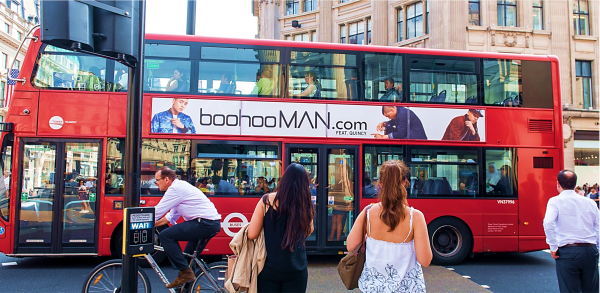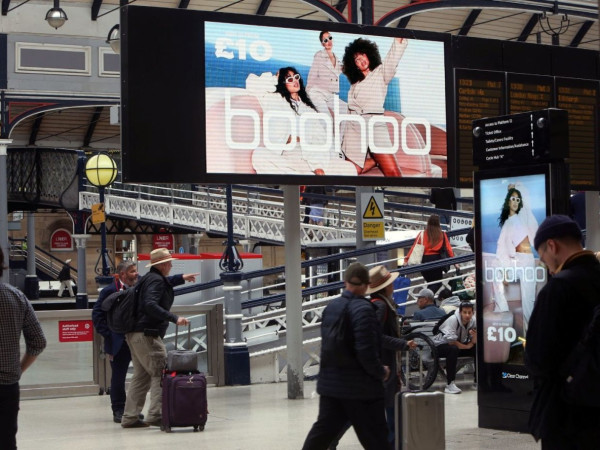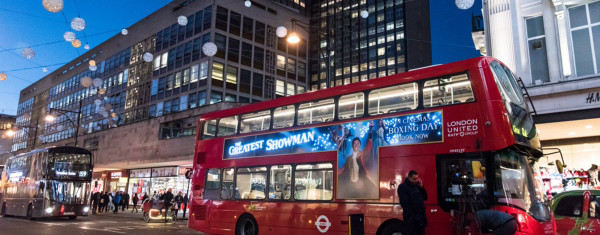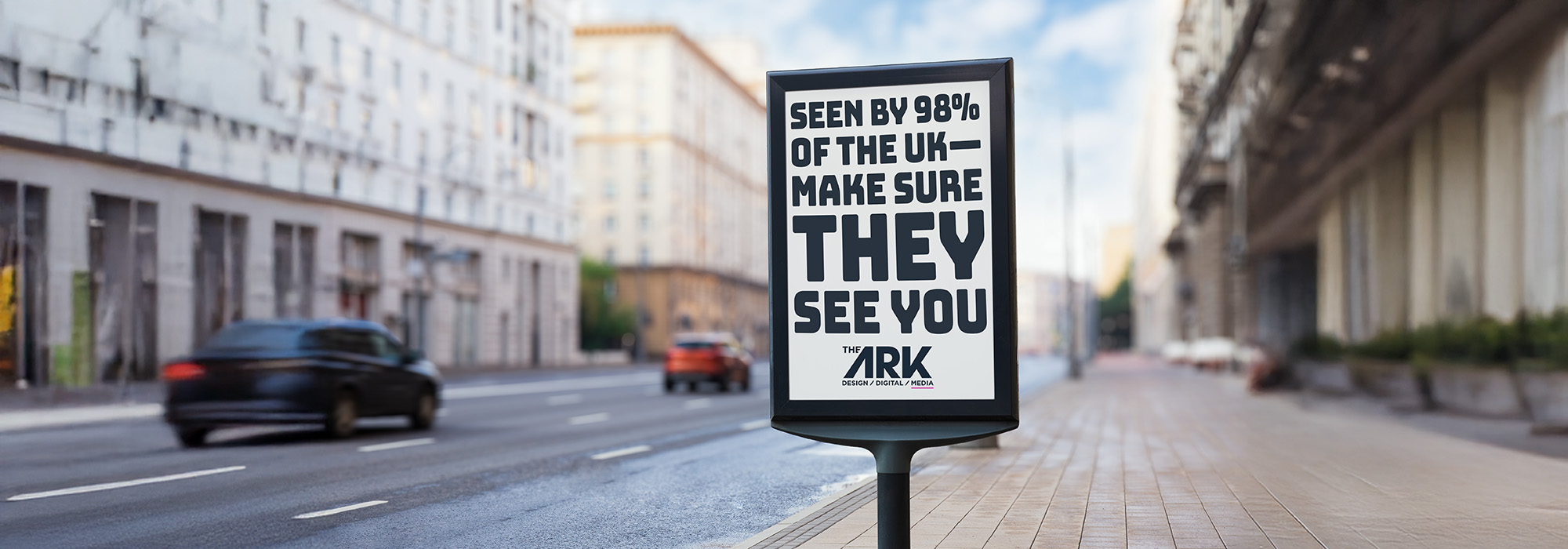What Is Out-of-Home (OOH) Advertising?
The average UK adult spends significant hours commuting, shopping, socialising or enjoying leisure activities outside their home. Out of Home (OOH) advertising takes full advantage of this, positioning brands in prime locations where they can be seen by thousands of people daily. Broad types of OOH include billboards (posters and digital screens), street furniture (bus shelters and signage), transit (buses, trains and taxis), and leisure/retail-based (cinemas and pubs).
From the beer mat you’re idly flipping to the giant billboard from your rush-hour queue, it's obvious that OOH is unmissable: seen by a huge 98% of the UK population every week. But did you know it’s also one of the highest-trusted, most engaging, and ROI-driven forms of advertising, surpassing media like print, radio, podcasts, TV, and even standalone mobile and online? With exciting digital and technological innovations, OOH is increasingly key to growing brand awareness, engagement, integrated campaigning, and website traffic, resulting in measurable increases in services, sales, and revenue.
Read on to discover more about this traditional technique that has evolved into a modern brand powerhouse.
Types of OOH
Thinking just billboards? Think again! The locations, opportunities, and scope for OOH advertising are now almost endless; reaching far beyond the familiar, conventional, and obvious, to the digital, interactive, and experiential.
OOH Location Opportunities
- Transport Advertising: Airport, railway, tram and bus stations; plane, train, tram, bus, and taxi interiors and exteriors; bus, tram and taxi shelters, also the London Underground system.
- Roadside Advertising: Billboards and posters, roundabouts, lamp posts and bollards; ad vans, bikes and walkers; motorway services, gantries and bridges; phone kiosks, roundabouts.
- Retail, Leisure & Location Advertising: Pubs, bars, hospitality and heritage; cinemas, petrol pumps, shopping centres and supermarkets; universities; washrooms, corridors and walkways; lifts, escalators, ticket gateways.
Static (OOH) vs Digital (DOOH)
Broadly splitting into two groups: traditional static OOH and digital (DOOH).
Technological and digital advancements have been a game-changer, increasing reach, dynamism and responsiveness; however, traditional methods have by no means been superseded. With a wide range of options, there is plenty of choice to match the absolute best fit for your message, customers, budget and brand, including a combination of traditional and innovative.

Static OOH Advertising
Static, printed formats from beermats to billboards and window stickers to street furniture, usually remaining in place medium to long-term.
Benefits:
- Broad reach and constant visibility in high-traffic locations
- Consistent, reinforced message building for sustained brand awareness and recognition
- Highly cost-effective for setup and longevity
Limitations:
- Static content, lack of updating and responsiveness
- No inherent ability to measure direct impact and campaign performance
Choose for:
- Building consistent, long-term brand awareness
- Reaching a large, general audience
- Budget-constrained campaigns where broad visibility is the aim

DOOH Advertising
Utilising digital screen technology to broadcast dynamic, real-time content, including rolling digital transport posters, video billboards, interactive screens and integrated gaming machine advertising.
Benefits:
- Flexible, dynamic content, responding to time of day, weather, footfall or demographic
- Targeting and personalisation, enabling precision targeting of tailored messaging
- Opportunities for interactive engagement and purchasing
- Enables data collection and analysis of ROI.
Limitations:
- Higher investment and running costs to install and maintain
- Higher potential for faults or damage (environmental, damage and vandalism)
Choose for:
- Targeted, flexible and real-time adaptive campaigns
- Dynamic, audience-engaging and interactive initiatives
- Robust, incisive campaign analytics
Consider a Hybrid Strategy
Just as with other input variables like location, pitch and materials, combining both OOH and DOOH can maximise reach, reinforce messaging, and create powerful, multi-layered campaigns that impact consumers throughout their day. A well-researched and directed campaign will match your target audience, message, budget and objectives with the right technology for optimum reach and return.
Benefits of OOH Advertising
Both traditional and digital OOH advertising have meaningful benefits, including cost, reach, engagement, and significantly higher perceived trust and credibility over other forms of advertising.
Reach and Visibility:
From the towering billboard to the teaser escalator screen, OOH adverts are eye-catching and engaging to a large, captive and receptive audience. Unlike inserted programme and media adverts, OOH appears appealingly diverting rather than intrusive, attracting positive attention and regard.
Enhanced Brand Awareness and Recall:
Consistent repeated exposure and subconscious familiarity across daily routines: commuting, shopping, eating, socialising, significantly improves positive brand memory and overall awareness. Studies show that up to 76% of people take action after seeing a DOOH ad, including visiting a website, store, or making a purchase.
Creative Scope and Impact:
OOH enables compelling communication through large, bold visuals and so much more. From a series of quiz beermats to multiple escalator-screen teasers, opportunities abound for creative, attention-grabbing visuals that make a lasting impression.
Strategic Location Targeting:
Gym advertising in the park, children’s clothing near schools, coffee on an early morning train platform, sleep aids, holidays and wine on a packed homebound Tube? The ability to place ads by location, demographic, even time, ensures your message is seen by your most desired audience and likely consumers.
Complement Other Ad Channels:
Maximise multi-platform messaging by using OOH to complement and work synergistically with digital, social media, TV, radio, and letterbox marketing, thereby reinforcing messages and increasing overall campaign effectiveness and ROI.
Brand-safe & trusted:
Consumer trust in OOH advertising is high and increasing, with consumers viewing it as a credible, public, and non-intrusive platform. According to Outsmart, the UK trade body, OOH adverts reach 98% of UK adults each week, yet account for just 2% of overall advertising complaints. Consumer trust in OOH advertising is 31%, nearly double the level of social media advertising.
The OOH Landscape in the UK
The modern UK OOH landscape is an increasingly dynamic, exciting and effective growing marketplace, offering brands new and diverse opportunities to connect creatively and materially with consumers in the real world.
OOH Statistics
- OOH total revenue for year-end 2024 was recorded at £1.4bn, the highest ever for the industry
- Year-on-year revenue growth reached a new peak of +7.7%
- UK spending in OOH for 2024 reached £1bn in December, an increase of 12% on 2023
- Classic OOH grew by 3%, with DOOH rising by 10.2%
- DOOH total revenue share stands at 66% of total OOH advertising
- OOH revenues for the first half of 2025 remain on track at £644.9m
Figures collated by PricewaterhouseCoopers (PwC)
Reach and Geographical Factors
Urban and rural environments and audiences offer different opportunities in terms of spend, audience, and penetration. Increasing urbanisation offers high population density and visibility, however saturation and rising costs are considerations; conversely lower rural population density can reap rewards from a potentially more engaged audience in a less competitive landscape.
Urban OOH: High visibility and reach. Offers high exposure, visibility and reach to a broad cross-section of society, especially in high-traffic areas. High competition for ad space can lead to saturation and higher cost per impression (CPI), making strategic location placement and creative messaging crucial to access the high engagement and returns available.
Rural OOH: Less traffic, more engagement. Lower population density equals lower overall exposure rates; however, less competition and ad clutter can also result in a more attentive and engaged audience, and lower CPI. Logistical considerations can include fewer OOH units available and a prevalence of long-term leases.
Both urban and rural OOH can offer significant ROI for the right product and well-designed campaign. Matching message and method to the right environment and employing innovative branding is key. For some campaigns, a combination of both can offer comprehensive returns, capitalising on urban visibility and rural engagement.
Leading Brands OOH UK Success Stories
While the increasingly creative use of digital and interactive media is expanding the boundaries of advertising potential, do not discount traditional OOH for perceived budgetary or priority concerns. Specsavers' superlative campaigns, for example, show how classic analogue OOH can maximise reach, trust, familiarity and engagement.
- Gladiator II: Paramount transformed London's Piccadilly into a Roman-themed spectacle, attracting major brands and winning plaudits for its creative and technological integration.
- Tesco Summer Roaming: Exemplifying contextually-relevant location placement, this campaign utilised live flight data at UK airports to promote Tesco Mobile's EU roaming benefits.
- GambleAware: Strategically placed in a high-harm gambling area, this used a deliberately confusing and opaque billboard image to create curiosity and engagement to symbolise the mental confusion of gambling addiction.
- Magnum Pleasure Express: The UK's largest 3D OOH campaign so far, displaying in prominent locations like London's Piccadilly and Manchester Printworks, the campaign created significant broadcast reach through an engaging blend of digital and physical experiences.
- Coca‑Cola: An innovative campaign letting consumers redeem codes via mobile phones to change the digital poster in real‑time, pushing DOOH’s interactive & flexible potential.
- Mars Wrigley: Partners of the Women’s World Cup, broadcast live scores in prominent locations with prize offers via QR codes.
- Specsavers: Impressively researched and creatively-led UK-wide campaign maximising traditional OOH poster effectiveness, engagement and return (industry-commended the “Perfect OOH Poster”).

OOH Trends and Innovations
With sharply rising trends in the overall OOH marketplace and future-forward AI and CGI starting to make science fiction advertising a reality, personalisation and integration into multi-channel campaigns will leverage even more advantages for forward-looking brands. Sustainability is proving a key consideration for consumers; brands capitalising on technology which reduces the environmental impact of advertising (as well as cost) gain measurably greater trust and engagement.
Digital growth:
At 66% of the overall OOH market, and forecast to grow to 75% by 2027, DOOH is becoming the dominant share. Enabling more dynamically rich creative formats and multi-channel pairing, consumers exposed to DOOH are 38% more likely to engage with a brand on mobile, making it a powerful partner in multi-channel campaigns. Increasingly, digital placements with good visibility and high footfall will become a premium.
Programmatic DOOH (PrDOOH):
The exciting upstart breaking out of DOOH, PrDOOH, uses software and algorithms to connect demand-side platforms (DSPs) for advertisers with supply-side platforms (SSPs) for media owners. Integrating real-time dynamic content adjustments based on data triggers like traffic surges and weather, it offers performance optimisation in a way that traditional, static out-of-home advertising cannot. Around 29% of UK DOOH campaigns have used programmatic buys, expected to rise to 36% in the next 18 months.
Mobile/Interactive Tie-ins:
Use of interactivity and dynamic creative optimisation (DCO) is increasing, utilising real‑time data and mobile access, QR code, and app tie‑ins to make campaigns more and engaging. Placing Near Field Communication (NFC) tags on products, posters, or at events encourages consumers to tap their smartphones for instant digital experiences, such as product information, early releases, offers, loyalty programmes and points, deepening interaction and engagement.
Sustainability:
As part of ESG, Brands are under pressure to reduce environmental impact visibly and are rewarded with greater trust and engagement when they do. Integrating sustainability metrics and innovations in energy-efficient hardware, such as carbon emission-reducing digital screens, into media planning and buying is a key consideration, as illustrated by Alight Media’s innovative green bus shelters.
Meaningful Measurement:
Moving beyond estimations, counts and questionnaires, integrating DOOH with broader marketing mix measurement equals more rigorous, standardised and advantageous data analytics. Evolving tools and standards enable a greater emphasis on upper-funnel metrics (likes, shares, clicks), which measure a campaign's ability to build brand awareness and interest through impressions, reach, website traffic, and engagement metrics, alongside traditional footfall, store-visit, and sales uplift conversions. In the modern marketplace’s drive for competing attention, this is your magic eye to tangible results.
AI and GCI in OOH:
From analysis to almost instantaneously reactive programming and personalisation, Artificial intelligence is sure to be an increasing element of DOOH advertising, enhancing campaign effectiveness through data-driven insights, enabling dynamic content adjustment, better audience targeting, and optimised ad placement. We are also at the cusp of “futuristic” campaigns combining AI and Computer-Generated Imagery (CGI) to create hyper-realistic, intangible outdoor ads that appear seamlessly integrated into real-world environments, creating intense social media buzz and spread. Watch this space!
Next Steps
Just like your customers can’t ignore OOH, you can’t afford to ignore it. Traditional OOH reaches mass audiences in high-traffic locations, building unprecedented trust over other channels, and creating a significant, unavoidable impact that drives brand awareness and memorability. Building on that standard, the expanding digital capabilities of DOOH and PrOOH offer exceptional targeted, contextual messaging, bridging the gap to online engagement, and providing a sustainable marketing option with strong ROI and results.
Why OOH Works Today
Key benefits include:
- Tangible Presence and Impact: Maximum visibility, memorability and positive familiarity, head and shoulders over in-home and in-media ads
- Trust and Credibility: Consumers perceive public advertising as a tangible commitment, building trust and credibility
- Mass and Targeted Reach: Reaches large, diverse audiences in their daily commutes and activities; DOOH enables precision time and environmental factor targeting
- Drives Online Engagement: Seamlessly directs audiences via QR codes or hashtags from the physical world to websites or social media, boosting online engagement and purchase consideration
- Cost-Effective: Offers a wide variety of economically attractive options for different budgets, with high ROI
- Sustainable: Utilising technological innovation, renewable energy, recycled materials and sustainable production and operations to demonstrate green commitment, credentials and ESG visibly.
- Complement Other Media: Effectively amplifies and integrates with digital, TV, radio, letterbox, media, online and viral campaigns, creating a comprehensive, impactful marketing strategy
- Results: Exceptional ROI, offering increased brand awareness and trust, engagement, interaction and sales conversion. One of the fastest-growing and most effective forms of advertising, can you afford not to?
Getting Started With OOH
Whether you are considering OOH for the first time or seeking to revitalise your message, the exceptional access, reach, return and innovation offered by modern OOH and DOOH campaigns are revolutionising the advertising landscape. Remember, 98% of people in the UK see some form of OOH advertising every week, with a 27% higher response in proactively performing a search for the brand after viewing an OOH ad than media like print and broadcast, and nearly double the level of brand trust (31%) than that achieved by social media.
At Ark Media, our investment in staying at the forefront of OOH advertising innovation has made us the first choice for many eminent brands. Helping you cut through the noise with OOH campaigns that are practical, measurable and effective, start your OOH journey to success with us.
We’d love to learn about your brilliant brand-
and help you shout about it!
Research/Stats/Numbers:
- https://www.statista.com/topics/5771/out-of-home-advertising-uk/
- https://www.statista.com/topics/5771/out-of-home-advertising-uk/#statisticChapter
- https://www.outsmart.org.uk/resources/ooh-key-stats (PWC)
- https://www.outsmart.org.uk/site/userfiles/File/20250213105629_Out_of_Home_Revenues_Q4_and_Year_2024_press_release.pdf
- https://www.outsmart.org.uk/keep-up-to-date/news/863/out-of-home-advertising-reports-p645m-of-revenue-in-the-first-half-of-2025
- https://www.outsmart.org.uk/why-ooh-works
- https://www.outsmart.org.uk/keep-up-to-date/news/779/why-are-ooh-ads-attracting-so-few-complaints
- https://www.route.org.uk/
- https://www.outsmart.org.uk/resources/research-reports
- https://www.signlink.co.uk/news/industry/uk-out-of-home-reports-best-ever-year/
- https://elitebusinessmagazine.co.uk/sales-marketing/item/why-businesses-should-invest-in-out-of-home-advertising
- https://www.thedrum.com/opinion/2025/05/19/genai-creative-just-about-change-the-face-out-home-advertising
- https://www.thedrum.com/open-mic/the-authenticity-advantage-ooh-advertising-in-an-era-of-ai-driven-skepticism
- https://solomonpartners.com/2025/07/30/location-based-targeting-enhances-digital-out-of-home-dooh-media/ (USA)

